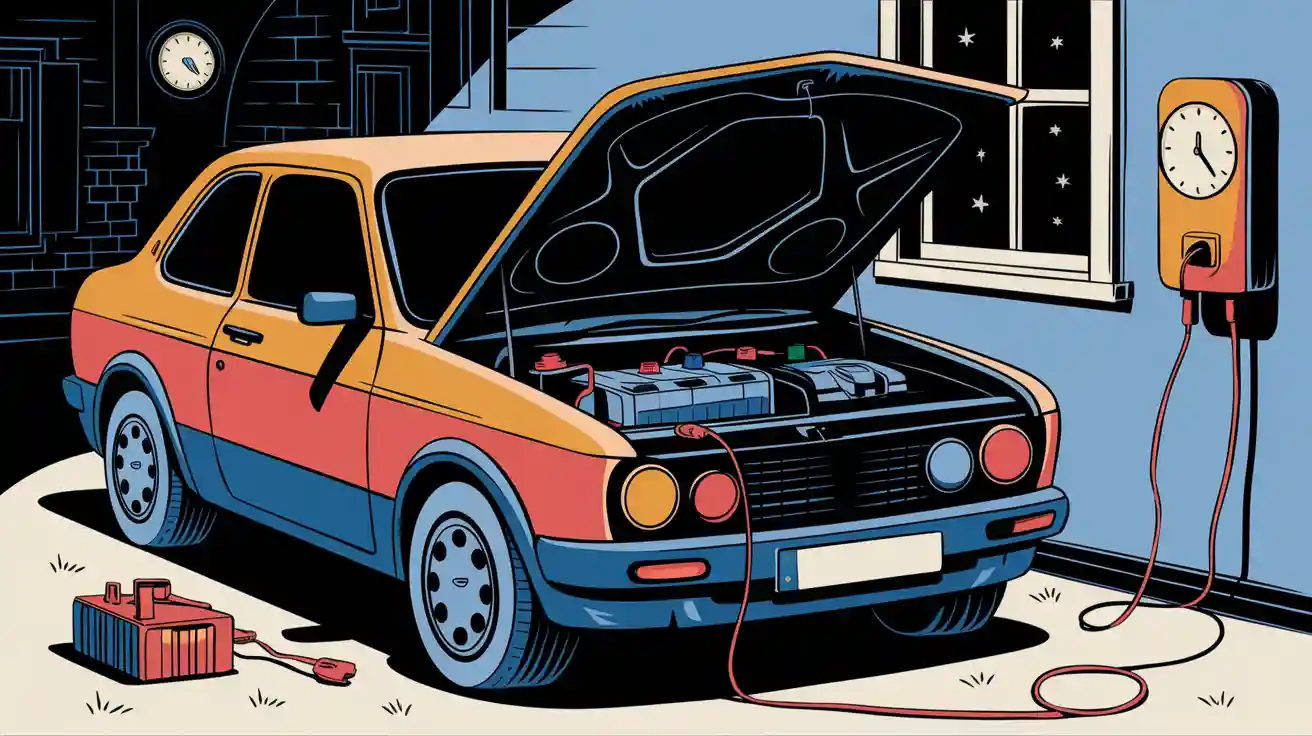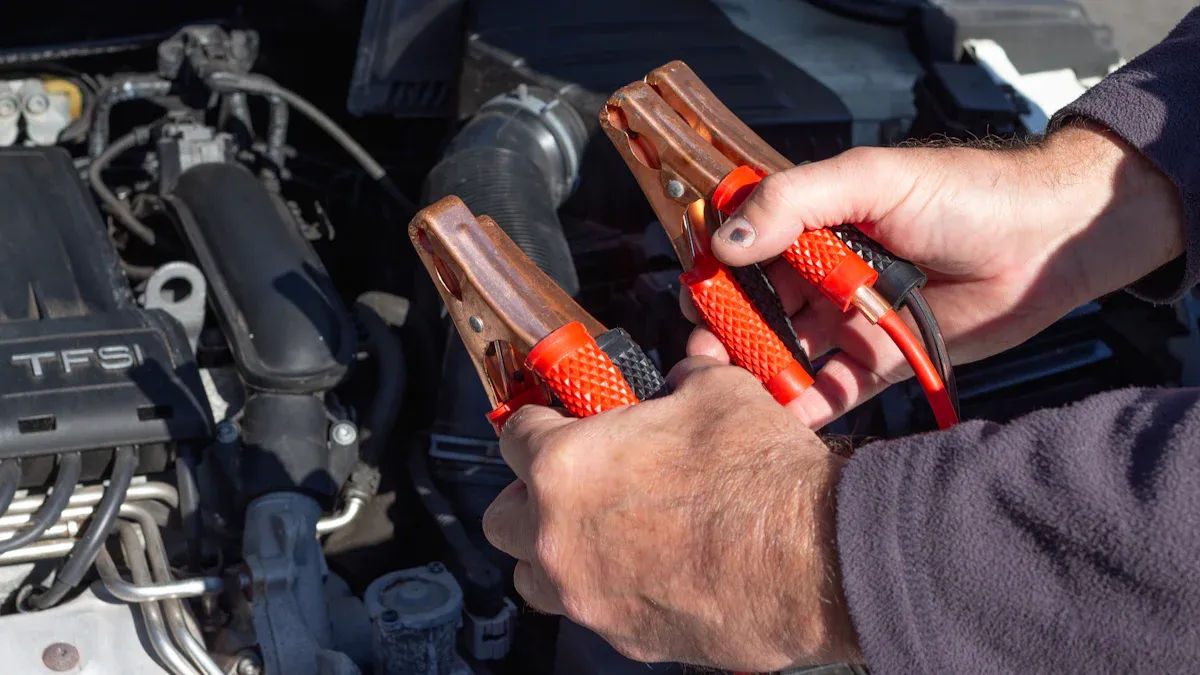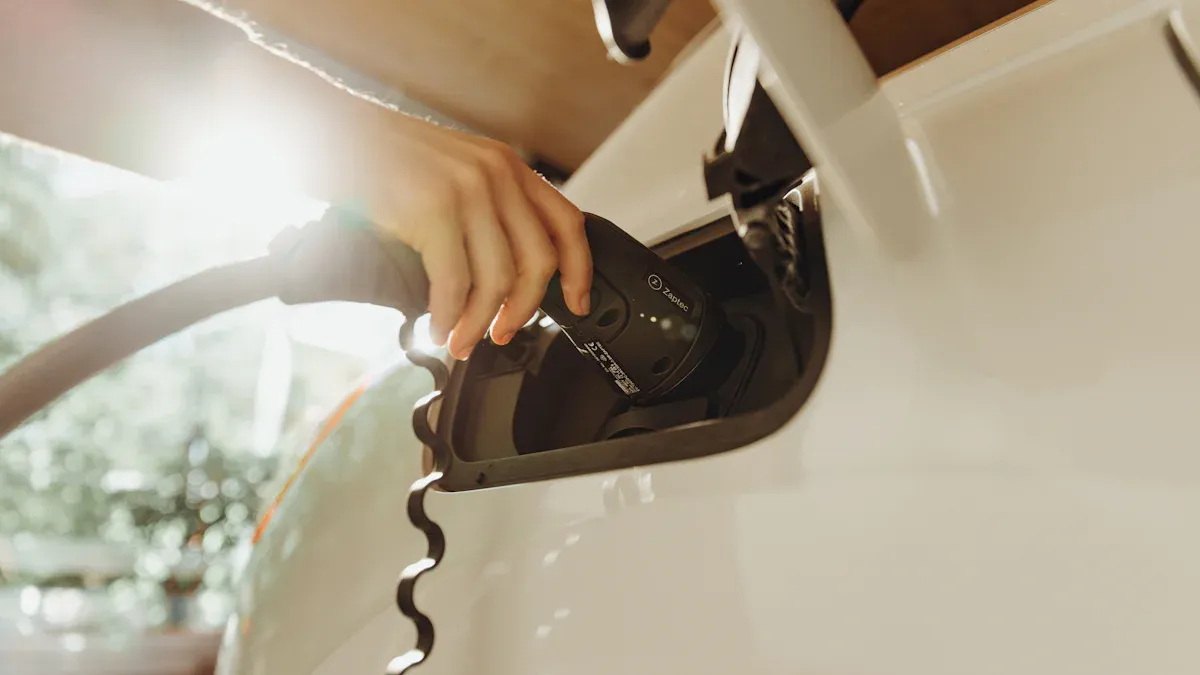
You must prioritize car battery charging safety by selecting the correct car battery charger for your lithium pack and monitoring its condition. Improper charging practices, such as neglecting trickle charge protocol, cause most failures. Although charger-related fire incidents remain rare, you should always follow best practices and manufacturer guidelines for safe operation.
Key Takeaways
Use smart chargers with automatic shutoff and safety features to prevent overcharging and extend battery life when charging overnight.
Avoid leaving standard or trickle chargers connected unattended, as they can cause overheating, battery damage, and fire risks.
Monitor battery charge levels and follow manufacturer guidelines to keep charge between 20% and 80%, ensuring safe, efficient, and environmentally friendly charging.
Part 1: Car Battery Charging Safety

Charger Types
Selecting the right car battery charger is essential for car battery charging safety, especially when working with advanced lithium battery packs such as LiFePO4, NMC, LCO, LMO, LTO, solid-state, and lithium metal chemistries. You must understand the differences between trickle, smart, and standard chargers to implement best practices in your operations.
Charger Type | Safety Features and Risks | Key Characteristics |
|---|---|---|
Trickle Charger | Continuously supplies low-level charge regardless of battery condition, leading to risks of overcharging, overheating, water loss in lead-acid batteries, and permanent damage. Requires manual monitoring to avoid these risks. | No automatic shutoff; constant power delivery; potential safety hazards if left unattended. |
Smart Charger | Uses microprocessor-controlled multi-stage charging (initialization, bulk, absorption, float). Automatically switches to maintenance/float mode when fully charged, preventing overcharging and overheating. Includes reverse polarity and surge protection, temperature control, and adaptive power draw. Stops charging automatically when battery is full. | Intelligent charge adjustment; automatic maintenance mode; enhanced safety features; extends battery life. |
Standard Charger | Provides a steady, constant charge without intelligent adjustment. Requires manual disconnection to prevent overcharging, posing risks such as overheating and potential fire hazards. | Simple, non-adaptive charging; no automatic safety features; user must monitor and disconnect manually. |
Smart chargers offer the highest level of car battery charging safety. They automatically adjust charging rates based on the battery’s status, which prevents overcharging and extends battery life. You benefit from features such as multi-stage charging, adaptive power draw, and built-in safety protocols against overheating and short-circuiting. In contrast, standard chargers deliver a constant charge and require manual disconnection, increasing the risk of overheating and fire hazards. Trickle chargers, while useful for maintaining charge, can cause significant safety issues if left unattended, especially with lithium battery packs used in medical, robotics, and industrial applications.
Tip: For critical infrastructure or security systems, always use a smart charger with advanced safety features to ensure compliance with car battery charging safety standards.
Overcharging Risks
Overcharging remains one of the most significant threats to battery performance and longevity. When you leave a car battery charger connected overnight—especially a standard or trickle charger—overcharging can occur, leading to severe consequences:
Physical damage such as swelling, bulging, or cracking of the battery case.
Leakage of electrolyte fluid, which can corrode terminals and surrounding components.
Excessive heat generation, resulting in reduced performance and potential fire hazards.
Noticeable reduction in the battery’s ability to hold a full charge, indicating battery degradation.
For lithium-ion chemistries (including NMC, LCO, LMO, and lithium metal), overcharging can cause lithium metal to deposit on electrodes, creating a significant fire hazard. This risk is especially critical in sectors like medical devices and robotics, where battery reliability is paramount. Overcharging may trigger thermal runaway, a dangerous chain reaction that can lead to uncontrollable fires and toxic fumes. Manufacturers mitigate these risks by implementing strict charging protocols, including battery management systems that monitor minimum and maximum battery charge, overheat protection, and automatic shutoff.
Note: Charging batteries overnight or unattended is discouraged. Always follow manufacturer guidelines and ev battery charging best practices to avoid battery degradation and ensure car battery charging safety.
Common symptoms of overcharging include:
Excessive heat during or after charging.
Swollen or deformed battery case.
Leakage of electrolyte.
Unusual sulfur or burning odors.
Dashboard warning lights or malfunctioning electrical components.
If you observe any of these signs, remove the battery from service and consult a professional for inspection and replacement.
Environmental Impact
Improper charging practices not only threaten safety but also contribute to environmental pollution and hazardous waste. Damaged batteries, especially lithium-ion types, can release hazardous metals such as cobalt, copper, nickel, lead, and thallium into the environment. These substances exceed regulatory safety limits under landfill conditions, contaminating soil and water and posing risks to human health and ecosystems. You must follow proper recycling and disposal protocols to minimize environmental harm. For more information on sustainable practices, visit our sustainability page.
Leaving a car battery charger connected overnight increases energy consumption and carbon emissions. Electricity use accounts for nearly 87% of the life cycle carbon emissions from electric vehicles. Overnight charging, especially with long idle times, leads to higher emissions. Smart charging strategies, such as shifting charging to periods of lower grid carbon intensity, can reduce emissions by up to 6% for overnight charging patterns. In regions with abundant solar energy, charging during the day can cut emissions by half compared to nighttime charging. For organizations committed to responsible sourcing, review our conflict minerals statement.
Best Practice: Implement smart charging and recycling protocols to support sustainability goals and reduce the environmental impact of your battery operations.
By following car battery charging safety guidelines and ev battery charging best practices, you protect both your assets and the environment. These practices are essential for maintaining high performance and reliability in demanding B2B application scenarios, from industrial automation to critical medical equipment.
Part 2: EV Battery Charging Best Practices

Monitoring Charge
You must monitor battery charge status in real time to maintain safety and optimize performance. Modern battery health monitoring systems for electric vehicles use high-resolution sensors to track voltage, temperature, state of charge (SoC), and state of health (SoH) for each cell. These systems employ advanced analytics and machine learning to predict degradation and optimize charging strategies. Integration with vehicle management platforms allows you to access real-time battery data through dashboards, smartphone apps, or cloud platforms.
Smartcar’s API technology communicates with built-in vehicle modems, delivering accurate SoC data remotely. You can estimate vehicle range and manage charging schedules without physical hardware connections. Ampcontrol’s smart charging software manages energy loads and prevents overcharging, supporting real-time monitoring and extending battery longevity. Flash Data Center provides interactive dashboards for fleet management, offering insights into charge states, temperature, and battery health. Machine learning predicts faults and enables proactive maintenance, which is critical for medical, robotics, and industrial applications.
Tip: Use battery monitoring apps to schedule charging sessions and limit charge levels overnight. These apps help maintain battery charge between 50% and 70%, reducing stress and minimizing battery degradation. Overtemperature protection features halt charging in high heat, preventing damage and safety risks.
Car Battery Charger Use
You must follow manufacturer guidelines and industry best practices to ensure safe overnight charging, especially for lithium battery packs such as LiFePO4, NMC, LCO, LMO, LTO, solid-state, and lithium metal chemistries. Battery management systems (BMS) play a vital role in preventing overcharging and maintaining minimum and maximum battery charge.
The BMS stops charging when the battery reaches full capacity, preventing excess voltage.
After reaching 100%, the system switches to trickle charging, maintaining battery level safely overnight.
Temperature regulation reduces or stops charging if overheating occurs.
Cell voltage balancing prevents uneven charging and damage.
Continuous monitoring of voltage, current, temperature, and SoC ensures safe operation and communication with external systems.
Follow these steps for safe charger use, as recommended by major automotive manufacturers:
Ensure the charger is off and unplugged before connecting clamps.
Connect the positive clamp to the positive terminal first.
Connect the negative clamp to the negative terminal, avoiding contact with other metal parts.
Plug in and turn on the charger; automatic chargers detect battery status.
Use a low amperage setting (2-6 amps) for safe charging and monitor for heat or issues.
Once charging is complete, turn off and unplug the charger.
Disconnect the negative clamp first, then the positive clamp.
Move the charger and clamps away before starting the vehicle.
Choose the right charger type; automatic chargers prevent overcharging.
Consult vehicle and charger manuals for specific instructions.
You should also manage accessories to support safe overnight charging. Battery maintainers, voltage monitors, and power stations help maintain charge and prevent battery degradation. Solar panels provide continuous trickle charging during the day, while higher amp chargers can be used periodically for full charges.
Accessory Type | Example/Product | Purpose/Effectiveness |
|---|---|---|
Solar Panel | 30W panel + 10A controller | Daytime trickle charging; best mounted on car roof |
Battery Maintainer | Battery Tender Jr. 800mA | Maintains full charge overnight; not for deeply discharged batteries |
Battery Voltage Monitor | INNOVA 3721 | Real-time voltage monitoring for battery health |
Power Station | Bluetti EB3A, Pecron E600 LFP | Powers chargers overnight when AC is unavailable |
Higher Amp Charger | Victron IP22 12/30A | Periodic full charging; avoids overloading power stations |
Note: Accessories such as battery maintainers and voltage monitors are essential for maintaining battery health in security systems, medical devices, and industrial robots.
Optimal Charging Time
You must adopt ev battery charging best practices to maximize battery longevity and minimize battery degradation. The optimal charging practice is to keep the battery charge between 20% and 80% for daily use. Charging to 100% should be reserved for special cases, such as long trips, cold weather, or BMS recalibration. This approach reduces voltage stress, heat buildup, and chemical degradation, extending battery life and improving performance.
Charging Practice | Lead-Acid Batteries | Lithium-Ion Batteries (LiFePO4, NMC, LCO, LMO, LTO, Solid-State, Lithium Metal) |
|---|---|---|
Daily Charging Range | 50-100% | 20-80% |
Full Charge Frequency | As needed | Occasionally (long trips, BMS recalibration) |
Temperature Management | Ventilation required | Avoid charging below freezing; monitor heat |
Maintenance | Water level checks, terminal cleaning | Maintenance-free; rely on BMS |
Charging Speed | Slower, less efficient | Faster, higher efficiency |
BMS Integration | Basic monitoring | Advanced BMS for cell balance, overcharge/over-discharge prevention |
Overnight charging is safe and convenient when you use smart charging features to limit charge levels. Modern EVs allow you to set charge limits, automating adherence to the 20-80% rule. Frequent full charges and deep discharges accelerate battery degradation, reducing battery longevity and performance. You should avoid charging immediately after heavy use when the battery is warm and schedule charging during cooler periods to reduce thermal stress.
Avoid charging above 80% to reduce stress and preserve battery life.
Do not let the battery discharge completely to 0%, as it harms the battery and components.
Prefer Level 1 or Level 2 charging overnight; reserve DC Fast Charging for occasional use.
Maintain the vehicle in moderate temperatures to help preserve battery longevity.
Frequent small charges (around 75-80%) are better than infrequent full charges.
Best Practice: Set daily charging limits between 40% minimum and 80-85% maximum state of charge. Use smart charging apps to schedule and limit overnight charging, especially for lithium battery packs in medical, robotics, and industrial sectors.
Ignoring manufacturer guidelines accelerates battery degradation, shortens battery lifespan, and increases long-term ownership costs. The battery represents nearly one-quarter of an electric vehicle’s total cost. Following recommended ev battery charging best practices helps maximize battery longevity and cost-effectiveness for your organization.
You should prioritize smart charger selection, real-time monitoring, and strict adherence to manufacturer guidelines for lithium battery packs like LiFePO4, NMC, LCO, LMO, LTO, solid-state, and lithium metal.
Use battery management systems to prevent overcharging and overheating.
Monitor charge status and avoid frequent full cycles.
Address charger faults quickly to reduce safety risks in medical, robotics, and industrial operations.
Smart charging overnight is safe when you follow these best practices.
FAQ
Can you leave a smart charger connected to a lithium battery pack overnight?
Yes, you can leave a smart charger connected overnight. Smart chargers prevent overcharging and support safe charging for LiFePO4, NMC, LCO, LMO, LTO, solid-state, and lithium metal packs.
What risks do you face when using standard chargers for overnight charging in industrial applications?
Overcharging
Fire hazards
Battery degradation
Standard chargers lack automatic shutoff, increasing risks for lithium battery packs in robotics, medical, and security systems.
How do you optimize overnight charging for lithium battery packs in critical infrastructure?
Practice | Benefit |
|---|---|
Real-time monitoring | Prevents overheating |
BMS integration | Ensures cell balance |
Charge limits | Extends cycle life |
You should follow manufacturer guidelines and use smart charging protocols for best results.




